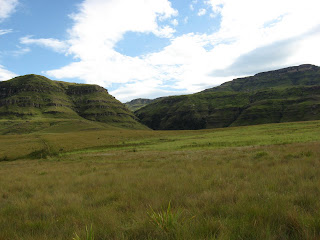A couple Fridays ago, school was cancelled because of student protests. I’m not entirely sure what they’re protesting for, but it’s been happening off and on at another campus of my university for the past few weeks and I think it generally has to do with complaints about financial aid. We found out at about 11am on Friday that the practical we were supposed to have on Saturday was also cancelled and there wasn’t a soccer game that week, so three of my friends and I decided to take the opportunity to go to the Drakensberg Mountains. We rented a car and Caroline was brave enough to drive for two hours on the left side of the road. We almost hit one cow. When we arrived at our hostel, the stars were amazing. There were tons and tons and tons of them, and it was a great view of the Milky Way.

We went hiking with a really great tour guide who told us about the Xam (the x is a lateral click) Bushmen who inhabited this area starting 10,000 years ago. He showed us which plants they ate, which had to be soaked in the river for three days before eating, and which are poisonous. Apparently nearly all of them tasted pretty bad, but we were able to drink the water in the streams and that was delicious.
Our guide also knew a lot about the animals of the area. This is porcupine poop.
He identified these as gray rhebuck just by the sound, and then let us look at them through his binoculars. (If you click on the picture, it'll load a bigger version.)
(There are more pictures of the beautiful mountains on my facebook.)
Our destination was Bushman paintings on several huge rocks. The predominant colour was red (from iron oxide), and they also used charcoal for black and bird poop for white. The pigments were mixed with fat so that the paintings they made with fingers or sticks endure for thousands of years.
Shaman painted what they saw while in a trance, so sometimes the people or animals had unrealistic extra body parts. For example this antelope’s tail is much longer than its legs.
The paintings in this area haven’t been dated, but researchers are pretty sure they were made sometime in the past 4,000 years. The oldest cave paintings in Africa, and likely the world, are found in Namibia and are over 20,000 years old. The Bushman put their paintings on top of those of previous generations, which makes it particularly difficult to date them. Based on his size and proportions, our tour guide identified the large man on the left as a Bantu person rather than a Bushman.
These paintings of elands incorporate the blending of two colours, which indicates that they are from the latest period of Bushman art. They painted animals to capture their spirit on the wall which made their hunt more successful the next day.
Nearly all the people painted are men (all the painters were also men), and anyone carrying a bow and arrows is definitely a man.
The few women are identifiable by their very large buttocks (apparently that’s how Bushman women looked.)
After lunch, we continued our beautiful hike.
When it’s raining and sunny at the same time, South Africans say it’s a monkey’s wedding. No one I’ve asked has any idea why, but at any rate, there was an amazing rainbow. We could even see just where it touched the ground, and though it was quite close to where we were, our guide insisted on going the other direction rather than searching for the pot of gold.













